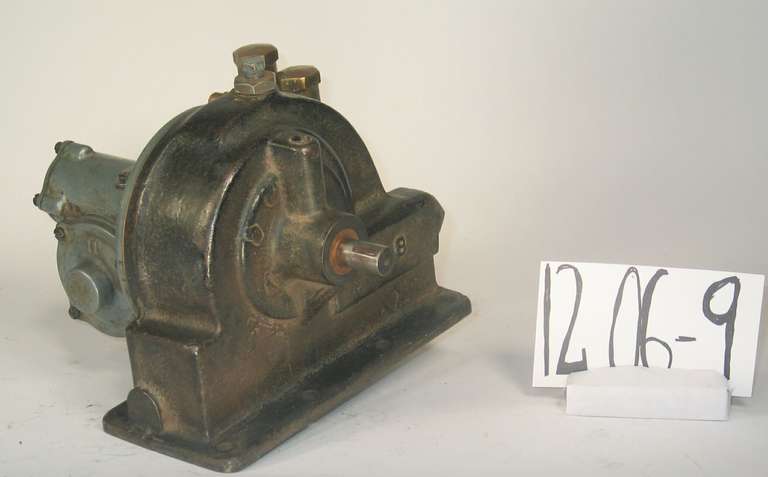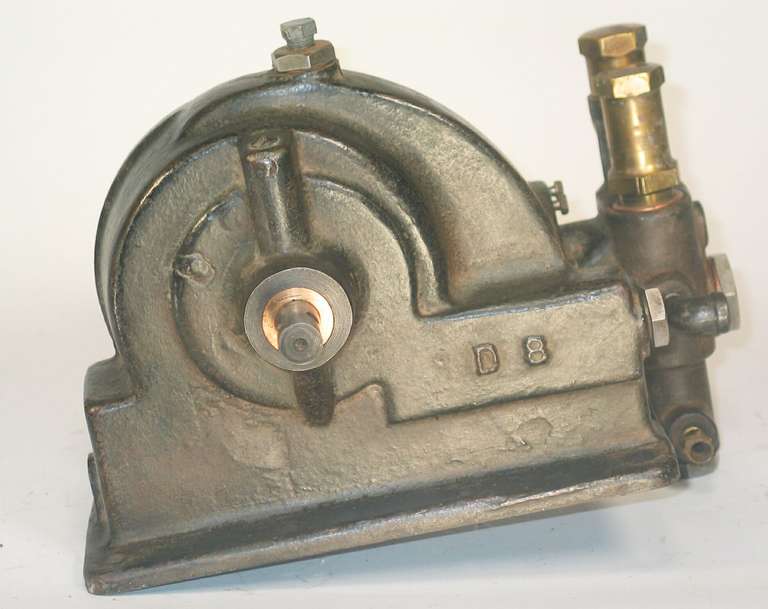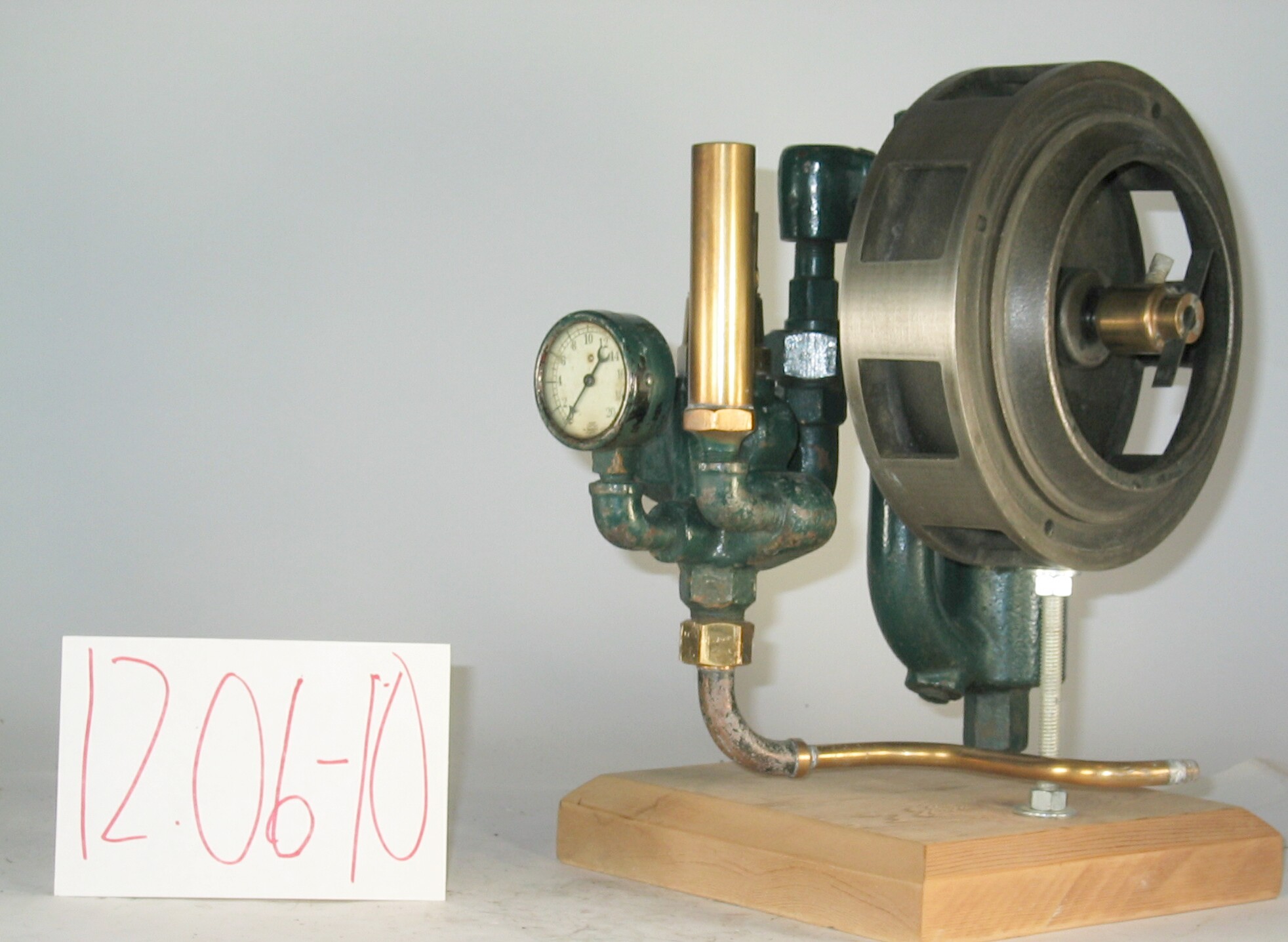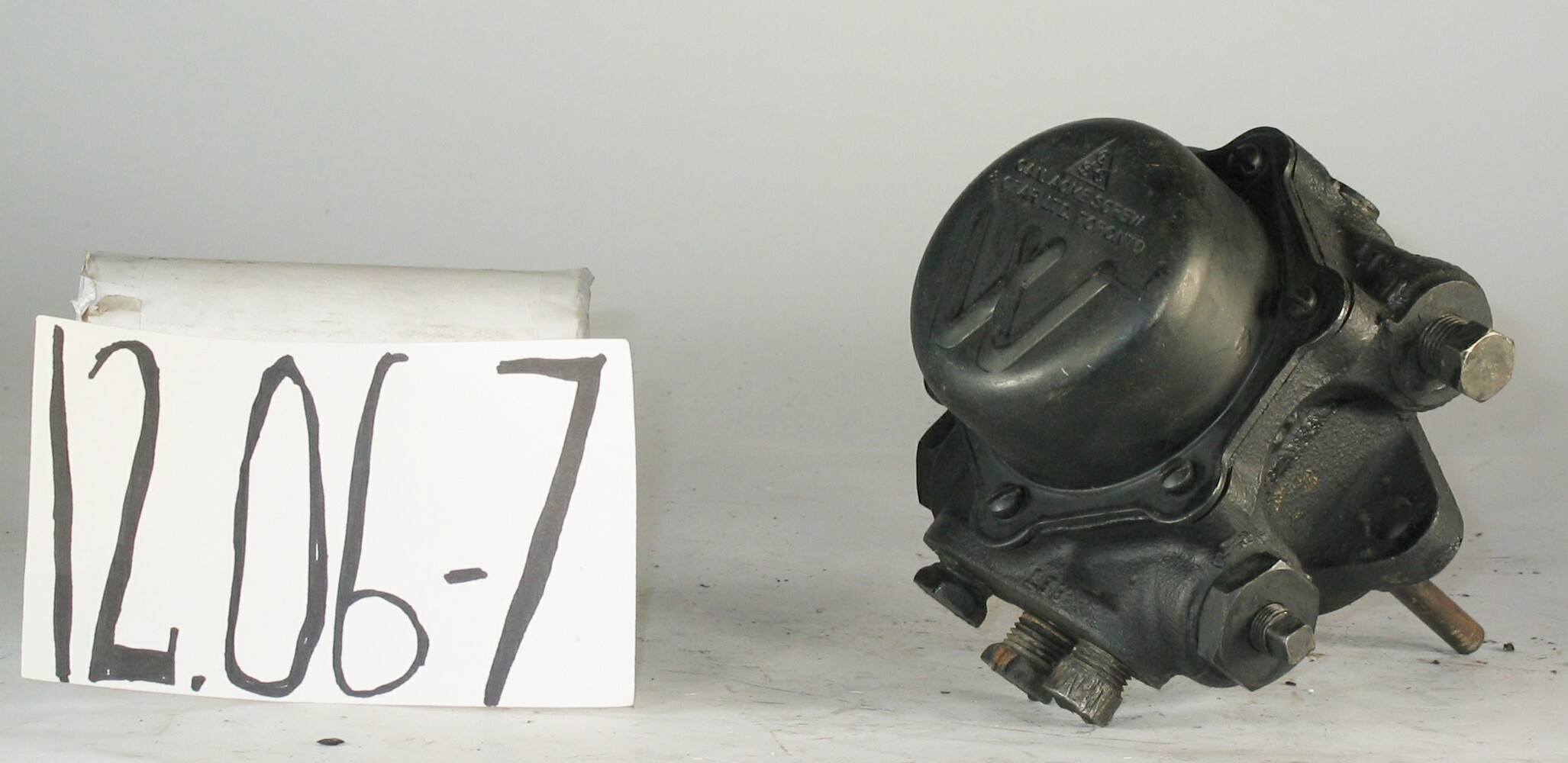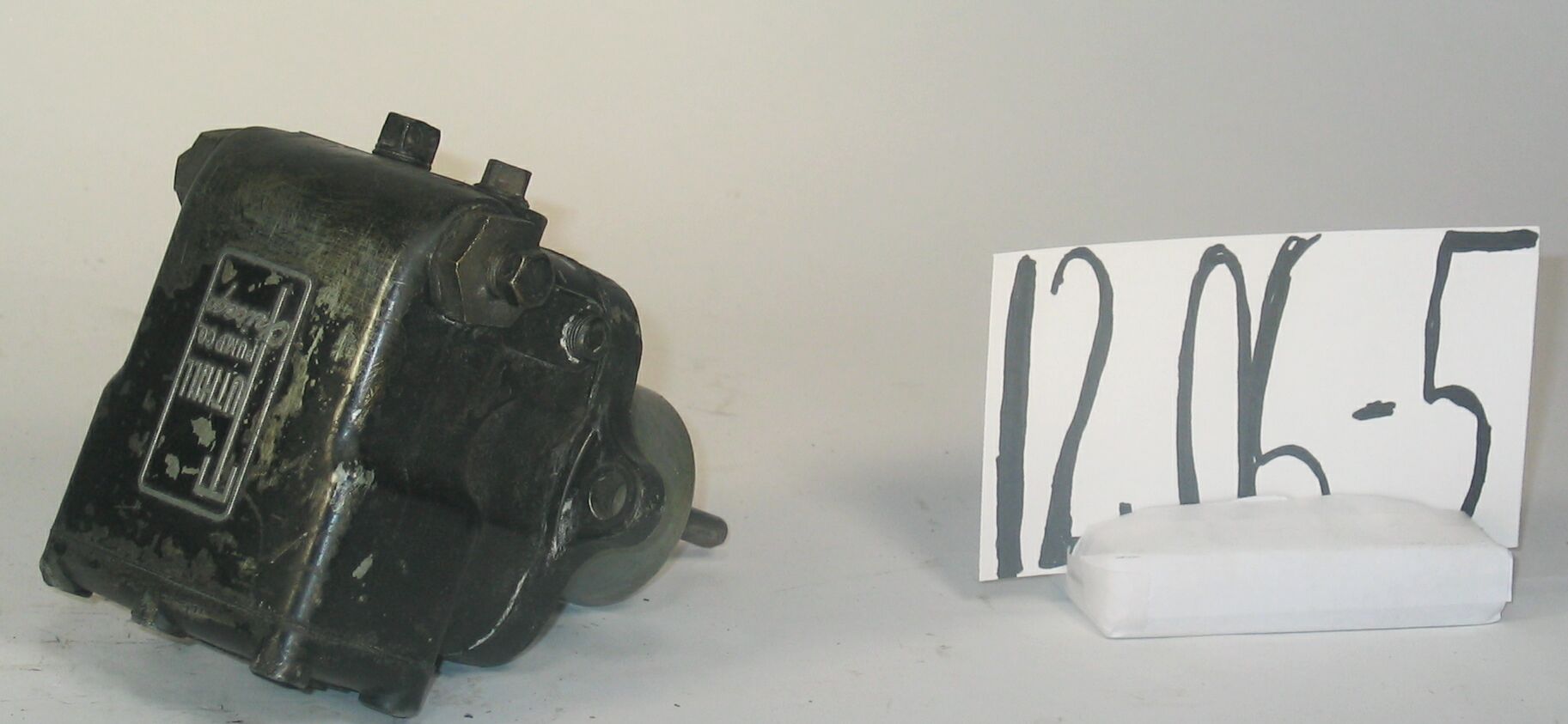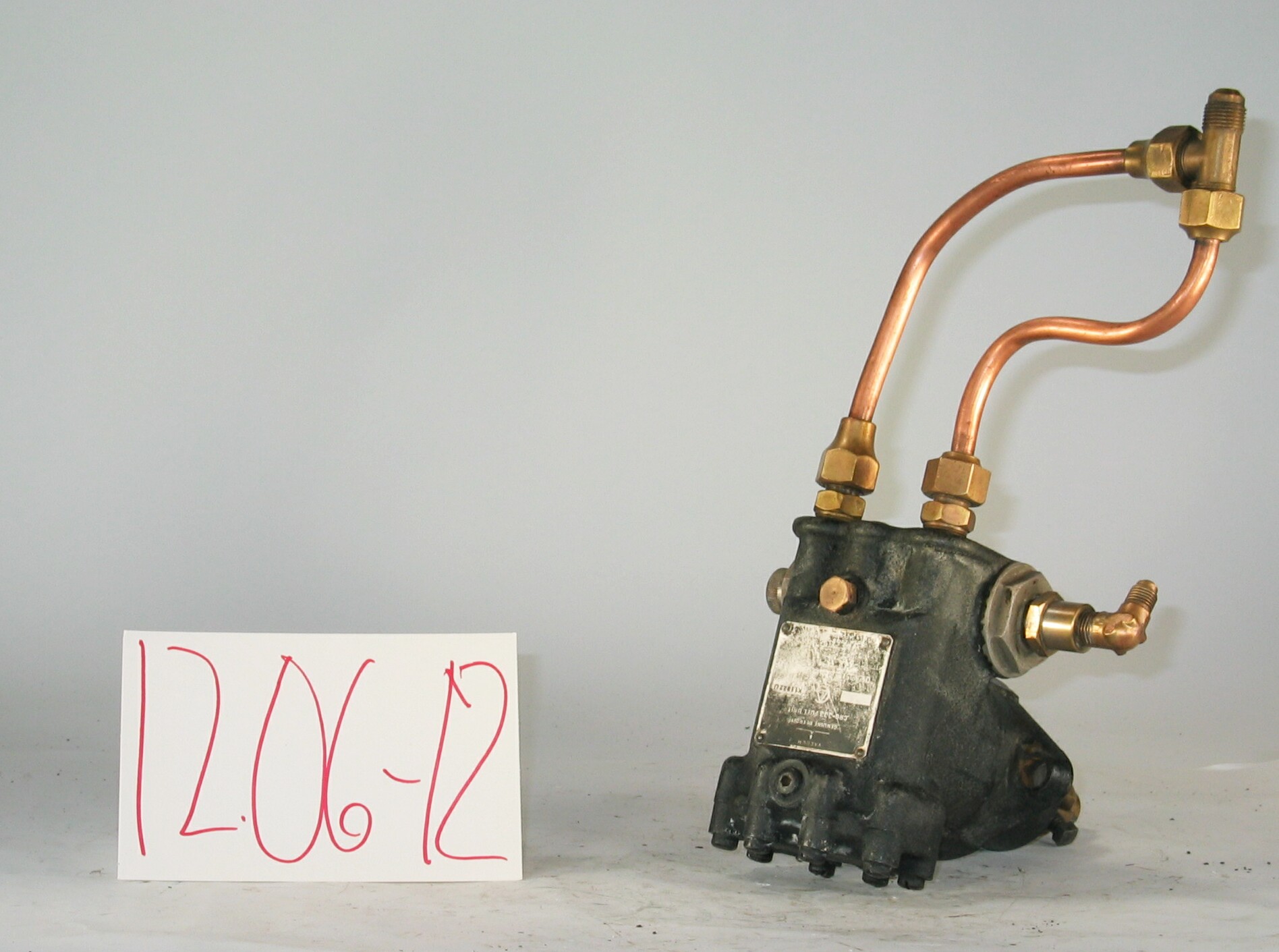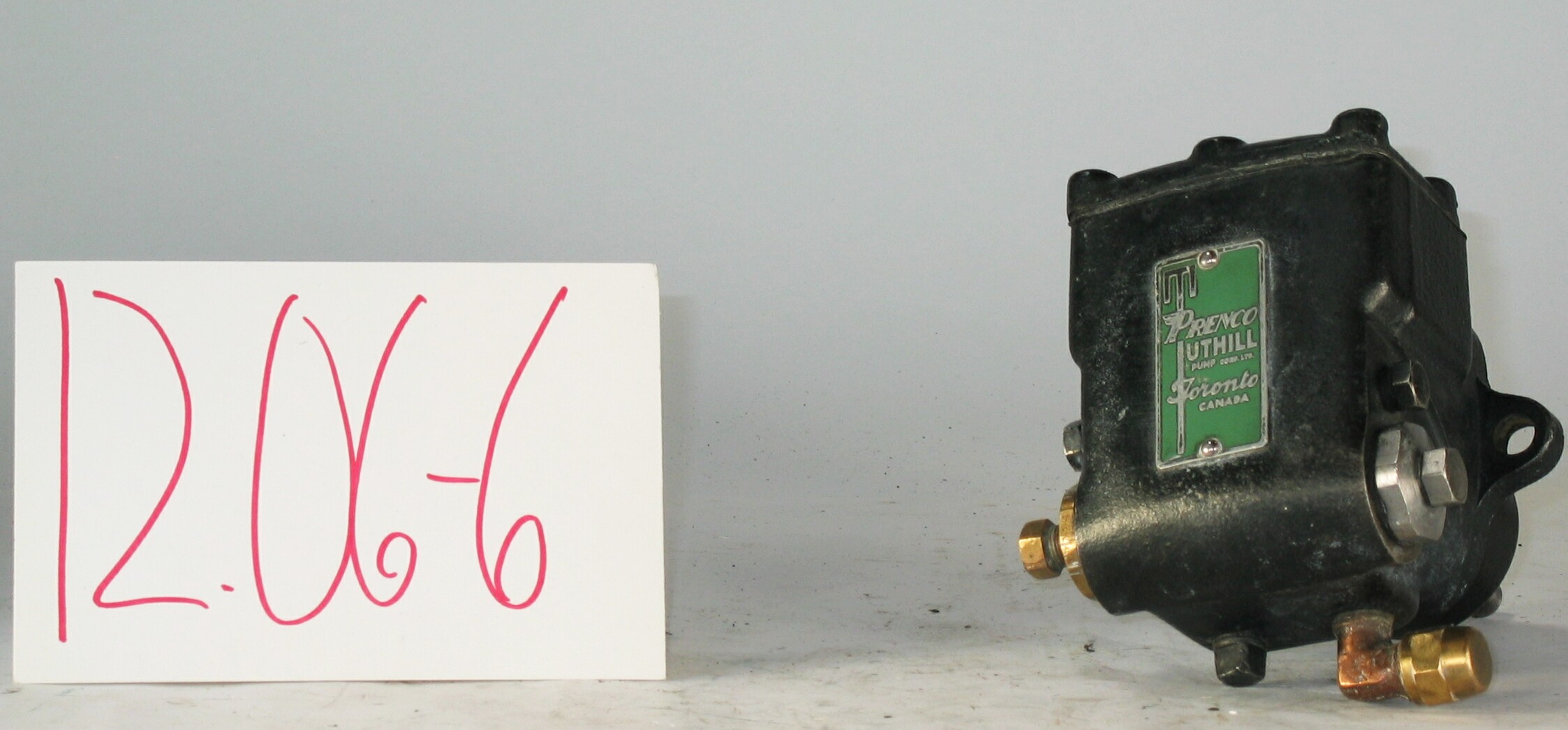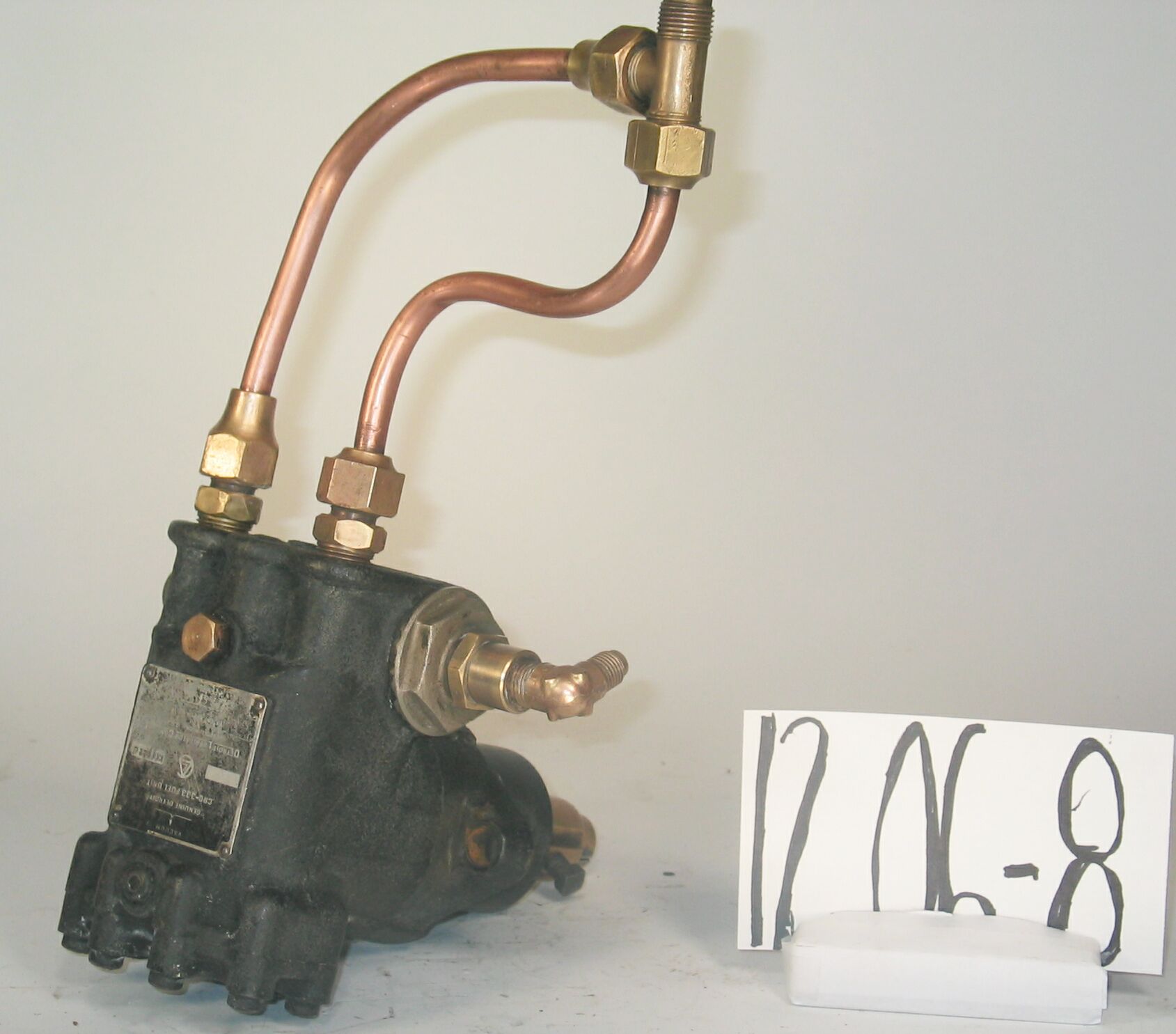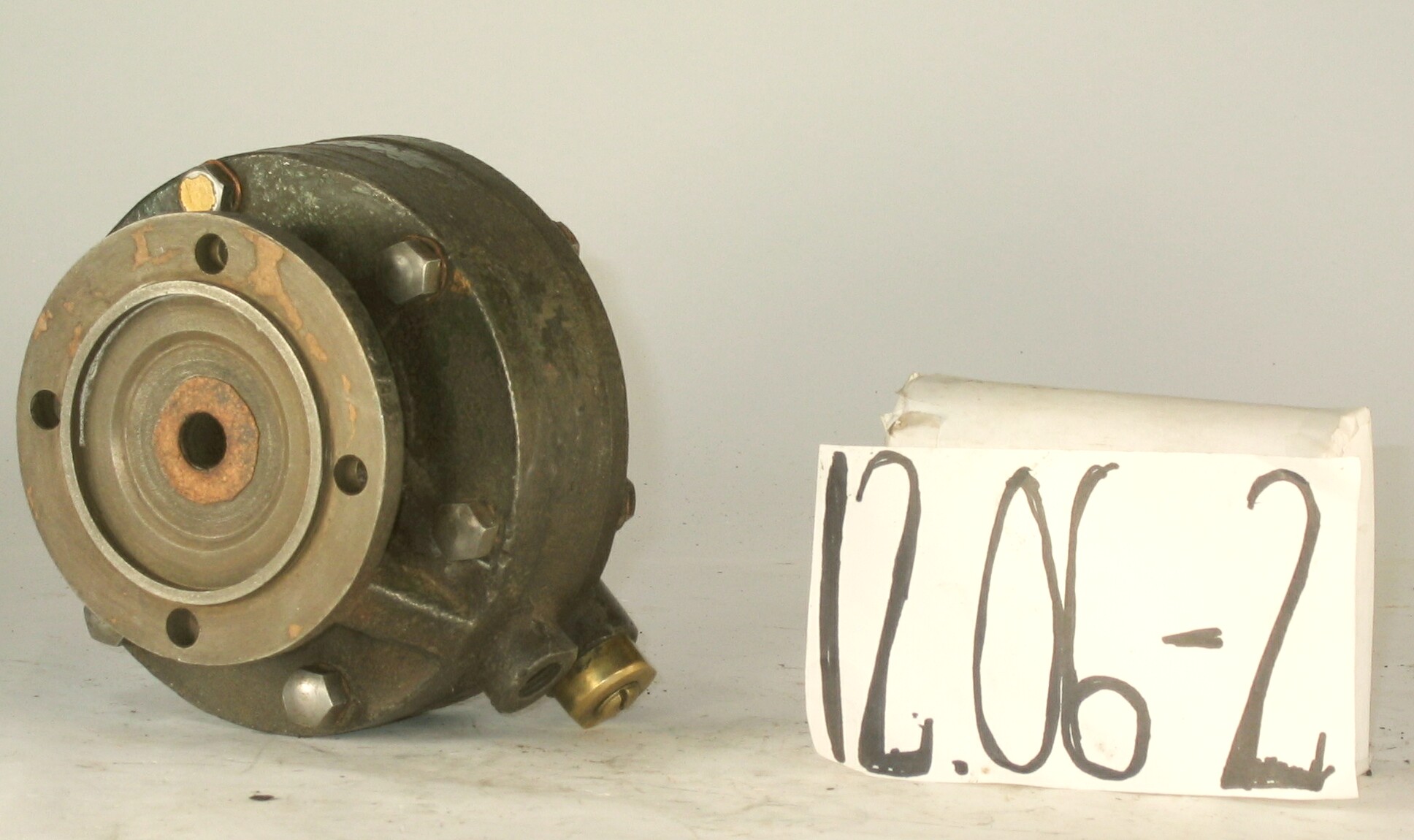12.06-9: Fess 1924 Fuel Pump Assembly for Mechanical Atomizing Oil Burner
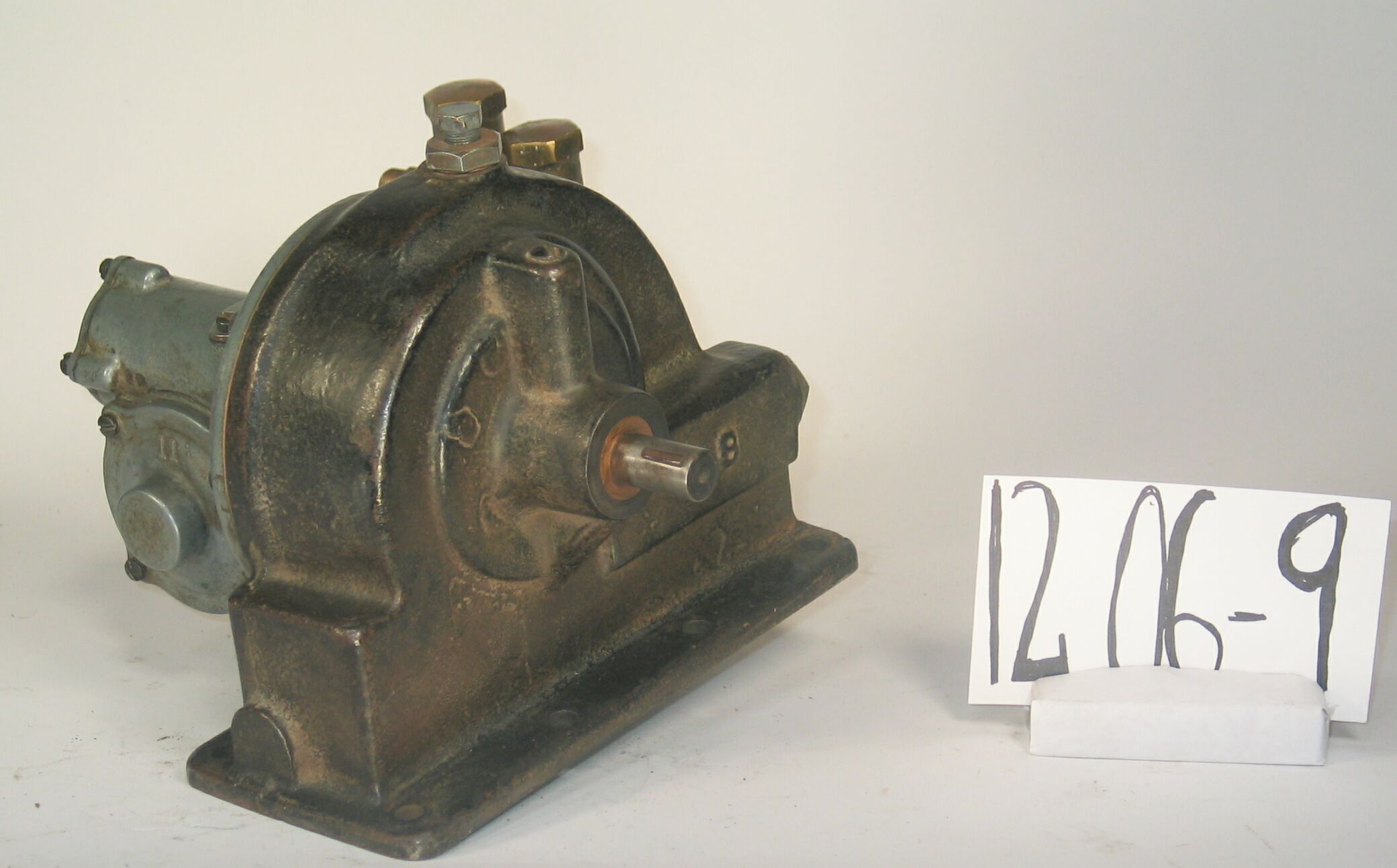
| HHCC Accession No. 2006.142 | HHCC Classification Code: 12.06-9 |
|---|
Description:
A fuel pump assembly for low pressure, mechanical atomizing oil burner, with direct, flexible coupled, electric motor drive, with carbon blade rotary pump, worm drive, gear pump, and automatic oil volume and pressure control valves, from the widely acknowledged pioneer of automatic oil heating equipment in Canada, Fess, Model D8, Circa 1924:
Group:
12.06 Pressure Atomizing Oil Burner Equipment and Systems - Fuel Pump Assemblies
Make:
Fess
Manufacturer:
Fess Oil Burner of Canada
Model:
D8
Serial No.:
Size:
10 x 10 x 8 inch h
Weight:
26 lbs.
Circa:
1924
Rating:
Exhibit, education, and research quality, illustrating the engineering and design of early, low pressure, mechanically atomizing oil burners for the Canadian home, by the widely acknowledged leader in the Canadian field
Patent Date/Number:
Provenance:
From York County (York Region) Ontario, once a rich agricultural hinterlands, attracting early settlement in the last years of the 18th century. Located on the north slopes of the Oak Ridges Moraine, within 20 miles of Toronto, the County would also attract early ex-urban development, to be come a wealthy market place for the emerging household and consumer technologies of the early and mid 20th century.
This artifact was discovered in the 1950’s in the used stock of T. H. Oliver, Refrigeration and Electric Sales and Service, Aurora, Ontario, an early worker in the field of agricultural, industrial and consumer technology.
This piece of oil heating equipment was installed and operated through the 1920’s and 30’s in an estate home in York County (York Region) north of Toronto.
Cracked and repaired die cast worm drive gear pump housing.
Type and Design:
Fuel pump assembly for low pressure, mechanical atomizing oil burner, Direct, flexible coupled electric motor drive, Carbon blade rotary pump, Die cast worm drive, gear pump, Brass automatic oil volume and pressure control valves,
Construction:
Material:
Special Features:
Accessories:
Capacities:
Performance Characteristics:
Operation:
Control and Regulation:
Targeted Market Segment:
Consumer Acceptance:
Merchandising:
Market Price:
Technological Significance:
They were the early years of the 20th century and “the machine” had arrived in the basements of a few well to do Canadian homes - whether the refrigerating machine [see condensing unit Group 2.01] or the automatic oil burning, home heating machine. The Fess Model D would typify the latter. Like many such arrivals it would first appear, celebrated for its potential contribution to human comfort, health and convenience, only much later as a social and cultural change agent with awesome impact on Canada and Canadians, their life and times.
The Model D [There was a series of them] represented the leading edge of self- powered, self-regulating, automatic oil heating technology of the period, likely the first wave of pressure atomizing technology commercially marketed in Canada. The mechanism was described by Fess as being of the low pressure, mechanical atomizing type, using “the retarded heat principle”. It consisted of what the Fess manual refers to as a “machine proper” and a “fire door insert”. The machine proper included a heavy steel pedestal on which was mounted this assembly consisting of a carbon blade rotary pump, worm driven gear pump, with rotary needle valve, including oil volume and pressure adjustments. The assembly was driven with a direct coupled repulsion induction motor [see Group 16.00], drawing oil from a float control, valve chamber with strainer. The entire machine proper rested in trays that caught leaking oil, with provisions for sucking it back into the system. The fire door insert included nozzle assembly, ignition transformer and spark plug The burner was controlled with a Model 77, Locksmith, stack switch [See Group 12.08]
Industrial Significance:
Appearing in the early 1920’s, Canadian household machinery was initially styled after its industrial counterpart in cast iron, steel, light weight die casting alloys, brass and bronze, using the industrial processes available in the times. Fess Oil Burners of Canada [later the John Wood Company, Toronto] became a major player in the development of the automatic oil heating industry, starting in the 1920’s The industry would shortly move on to a more compact, functionally integrated, unitary equipment look, thus distancing itself from the factory floor. See ID# 267 - but for now the D series was as good as it gets.
Socio-economic Significance:
From the vantage point of the early 21st century it is difficult to imagine the sense of promise the machines [oil burners and refrigerators] of the early 1920’s held for home owners, for a less arduous, richer and more rewarding life style. The public’s desire for relief from the hardships of the period and its increasing desire for comfort were cards that were well played by the oil heating industry of the times, justifying significant new engineering and capital investment in the research and development of oil heat technology and the manufacturing capacity needed. The availability of labor saving, motorized machines of convenience for the home, including refrigerators, oil burners and water pumps, further fed the public’s interest in hydro electrification, which was completed in much of central, urban Canada by the mid 1930’s - although for many much later. As a consequence, as the technology matured through the 1930’s and 40’s, the oil burner would become a commonplace in urban Canada, although much of rural Canada would wait another 30 years or more, for the benefits of home and farm electrification, necessary as a basic prerequisite for such modern comforts. For many Canadians it would be part of the economic boom that followed W.W.II
Socio-cultural Significance:
In spite of an inherently cautious Canadian public and its attitude towards new fangled, electro-mechanical contraptions in the early years of the 20th century, consumer interest in automatic oil heating equipment for the home grew surprisingly rapidly - amongst those that could afford to aspire to such luxuries in a period of national economic depression. Household machines, refrigerators and oil burners in the basement, would be the “show and tell” subjects of the day for many upper-middleclass homeowner, those with interests in ‘conspicuous wealth’, anxious and willing to demonstrate their latest life style purchases. The master narrative told here, the one to which almost all others relate, is that of the emergence of ‘machinery in the Canadian home’. As the 20th century dawned, Canadians, accustomed to their resource-based, extractive economy were used to transportation, traction and motive power machines in farm, mill and factory, where they seemed to rightfully belong. With the 1920’s, however, all that was about to change ‘ and change dramatically Here-to-for, the familiar motive power, rotating machines of farm, mill and factory were driven by central station power plants, water, steam and later internal combustion engines. But it was with the advent of motive power packaged in unitary, moveable forms, as in the ‘stationary’, gasoline engine [explosion engine] and the electric motor that a new era in motive power was made possible for home, as well as for farm, mill and factory applications It was principally the fractional horsepower, single phase, induction electric motor [see note #1] that made possible the introduction of machinery into the home, and with it ‘the end of quiet’ [see historical artifacts Classification Group 16,00, see Reference #1].
With the introduction of self powered machines into the home also came the introduction of automated, self regulating machinery, machinery that would turn iteself on and off, without the touch of human hand - the refrigerator, oil burner and water pump. These automated, inanimate objects also introduced new rhythms into the home, each with its distinctive hum and beat, each coming on and off with its own unique operating rhythm. The aroma of oils, vapours and materials, once foreign in the household, would also fallow. The 20th century ‘electro- mechanical’ Canadian home had arrived, much the same as the digital Canadian home would arrive in little more than half a century later ‘ changing all. The consequences were profound, spelled out in terms of the social, cultural and economic changes wrought.
Donor:
G. Leslie Oliver, The T. H. Oliver HVACR Collection
HHCC Storage Location:
Tracking:
Bibliographic References:
Instructions for Installation, Fess Automatic Oil Burners, TypyJR, TypeF, DA, DS, DAE, D3, BI, Fess Oil Burners of Canada Limited, Toronto, undated
Notes:
Related Reports:
CMX02 and CMX04 Calalogue item H2
